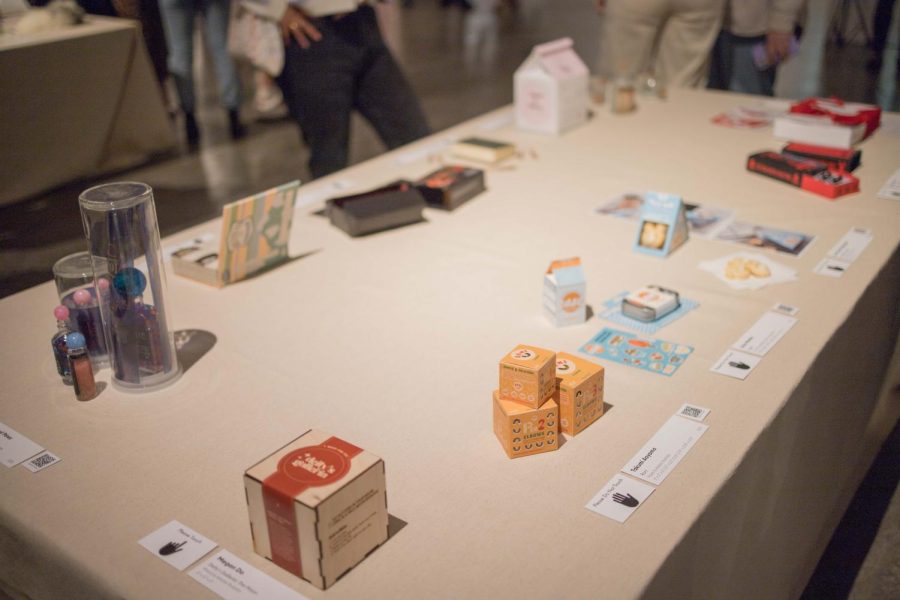BLOOM Exhibition Showcases Design Students’ Growth
Table projects at “Bloom” exhibit
For the past two years, the pandemic forced Seattle University Design students to hold their end-of-year exhibition virtually. With restrictions lifted this year, students are finally able to display their work at the BLOOM Exhibition. Held in the Vashon Gallery, the BLOOM Exhibition opening reception was held on April 21, but the work of the dedicated Design cohort will be available to view in the gallery until May 13.
“The theme is celebrating us blooming into who we are and celebrating the mix of aesthetics that we all hold and the identities that we all have,” Third-year Design major Rachel Bentfield said.“We wanted to acknowledge a lot of the hardships that people have gone through in the past two years and are still going through. Today we are blooming with all of our work.”
Design Professors Naomi Kasumi and Lucas Boyle oversaw the event. Fourth-years Jet Velasco and Bridgette Huhtala were elected co-directors of the exhibition by their peers.
“The exhibition is completely run by the 30 students in our cohort,” Velasco said. “We started working on it in November. It took a long time. It was a lot of hard work—but we are so excited for everyone to see it.”
The projects displayed at the event were products of numerous in-class assignments from the 29 third and fourth-year students’ time in the Seattle U Design program. While the majority of the projects on display were from the students’ senior year, some chose to include pieces from as far back as sophomore year.
“It’s a way to celebrate all the work we have been doing for the past year—and even for the past three or four years,” Bentfield said.
The exhibition featured a range of projects including a package design, product design, infographic design and identity design. Students had the freedom to choose a few of their favorite pieces to showcase.
Bentfield submitted an infographic, which required her and her classmates to research a topic and compile the information on a 24-by-36-inch poster. She also displayed a physical piece titled “Fairy Wings,” ear jewelry in the shape of fairy wings designed to wear with AirPods. Bentfield curated a playlist for the wearer that was accessible via a near-field communication chip.
“My design aesthetic is very natural, organic and contemporary,” Bentfield said. “I think that really shows through my work.”
Many of the projects are products of what Kasumi refers to as the “Design Boot Camp.” The Boot Camp is a series of upper-level design classes spanning fall and winter quarter and ending with the senior synthesis spring quarter.
“We call it the Boot Camp because they have no time to rest,” Kasumi said. “It’s almost like professional training. They have to do so much work in so little time. After the Boot Camp, they are pros.”
The exhibition is one aspect of the Design cohort’s senior synthesis. The students’ senior synthesis also includes compiling a portfolio and reflection upon key elements of Seattle U’s mission. This year, the Design program interpreted the mission through an anti-racism campaign using design as the medium.
“We are the communicators. We use our design skills to really promote anti-racism in society,” Kasumi said. “We have a lot of those challenging discussions about how we participate as an artist and a designer and how to utilize our skills for social justice.”
While Design students will graduate, Kasumi’s hope is that her students will go out into the industry and use their skills to enact positive change.
“I’ve learned to be more aware and intentional about decisions I make in my work,” Velasco said. “Our program really focuses on creating a well-rounded individual.”
This year marks the first year the design exhibition has included a physical installation as well as a corresponding virtual installation. This year’s designers’ work can be found in the Vashon Gallery and is accessible online along with artist profiles.
“I think computer technique can be done with anybody, but this group is special because we are in the same time, in the same moment, in the same classroom. We learn together,” Kasumi said. “We recognize that every moment is so precious, especially after COVID-19 lockdown. Everybody’s work is so much more sophisticated because we critique, comment and help each other, and it makes them better designers.”


